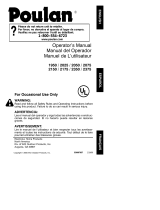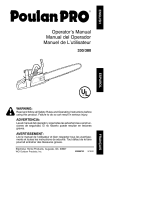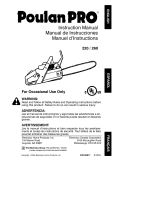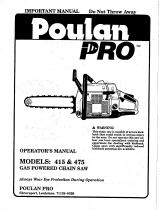
13
RANTY LASTS OR THE EXC LUSION OR
LIMIT A TIONS OF INCIDENTAL OR CONSE-
QUENTIAL DAMAGES, SO THE ABO VE
LIMITATIONS OR EXCLUSION MAY NOT
APPLY T O YOU.
ELECTROLUX HOME PRODUCTS NORTH
AMERICA ’S policy is to continuously impr ove
its products. Therefore, ELECTROLUX
HOME PRODUCTS NORTH AMERICA re-
servestherighttochange,modify ,ordiscontin-
uemodels, designs, specifications, andacces-
sories of all productsat any time without notice
or obligation to any purchaser.
U.S. EPA
EMISSION CONTROL
WARRANTY STATEMENT
YOUR WARRANTY RIGHTS AND OBLIGA-
TIONS: The U. S. Environmental Protection
Agency and POULAN/WEED EATER, DIVI-
SION OF WCI OUTDOOR PRODUCTS are
pleased to explain the emissions control sys-
tem war r anty on your lawn and garden equip-
ment engine. All new utility and lawn and gar-
den equipment engines must be designed,
built, and equipped to meet the stringent anti--
smog standards. POU L AN/WEED EATER
must war rant the emission control system on
yourlawnandgardenequipmentengineforthe
periods of time listed below provided there has
been no abuse, neglect, or improper mainte-
nance of your lawn and garden equipment en-
gine. Your emission control system includes
parts such as the carburetor and the ignition
system. Where a warr antable condition exits,
POULAN/WEED EATER will repair your lawn
and garden equipment engine at no cost to
you. Expenses covered under warr anty in-
clude diagnosis, parts and labor. MANUFAC-
TURER’S W ARRANTY COVERAGE: If any
emissionsrelated parton yourengine (aslisted
under Emissions Control War r anty Parts List)
is defective or a defect in thematerials orwork-
manship of the engine causes the failure of
such an emission related part, the part will be
repairedorreplacedbyPOULAN/WEEDEA T-
ER. OWNER’S W ARRANTY RESPONSIBI-
LITIES:Asthelawnandgarden equipmenten-
gine owner, you are responsible for the
performance of the required maintenance
listed in your Owner’s Manual. POULAN/
WEEDEATERrecomm endsthat you retain all
receipts covering maintenance on your lawn
and garden equipment engine, but POUL AN/
WEED EATER cannot deny war r anty solely
for the lack of r eceipts or for your failure to en-
sure the performance of all scheduled mainte-
nance. As the lawn and garden equipment
engine owner, you should be aware that POU-
LAN /WEED EA TER may deny you war r anty
coverage if your lawn and garden equipment
engine or a part of it has failed due to abuse,
neglect, improper maintenance, unapproved
modifications, or the use of parts not made or
approved by the original equipment manufac-
turer. You are responsible for presenting your
lawn and garden equipment engine to a POU-
LAN /WEED EA TER authorized repair center
as soon as a problem exists. Warr anty repairs
should be completed in a reasonable amount
of time, not toexceed30days. If you have any
questions regarding your war r anty rights and
responsibilities, you should contact your near-
est authorized service center or call POUL AN/
WEED EATER at 1--800--554--6723. WAR-
RANTY COMMENCEMENT DA TE: The
war ranty period begins on the date the lawn
and garden equipment engine is purchased.
LENGTH OF COVERAGE: This war r anty
shall be for a period of two years from theinitial
date of purchase. WHAT IS C OVERED:RE-
P AIR OR REPLACEMENT OF P ARTS. Re-
pair or replacement of any war ranted part w ill
be perfor med at no charge to the owner at an
approved POULAN/WEED EA TER servicin g
center. If you have any questions regar ding
your warr anty rights and responsibilities, you
should contact yournearest authorizedservice
center or call POULAN/WEED EA TER at
1--800--554--6723 W ARRANTY PERIOD:
Any warranted part which is not scheduled for
replacement as required maintenance, or
which is scheduled only for regular inspection
to the effect of“r epair orreplace as necessary”
shall be warranted for 2 years. Any warr anted
part which is scheduled for replacement as re-
quired maintenance shall be w ar r anted for the
periodoftime up to the first scheduledreplace-
ment point for that part. DIAGNOSIS: The
ownershall not be chargedfor diagnostic labor
which leads to the determination that a war-
ranted part is defective if the diagnostic wor kis
performed at an approved POULAN/WEED
EATER servicing center. CONSEQUENTIAL
DAMAGES: POULAN/WEED EA TER may
be liable for damages to other engine compo-
nents caused by the failure of a war rantedpart
still under warranty. WHAT IS NOT COV-
ERED: All failures caused by abuse, neglect,
or improper maintenance are not covered.
ADD--ON OR MODIFIED P ARTS: The useof
add--on or modified parts can be grounds for
disallowing a warr anty claim. POUL AN/WEED
EATER is not liable to cover failures of war-
ranted parts caused by the use of add--on or
modified parts. HOW TO FILE A CLAIM: If
you have any questions regarding your war-
ranty rights and responsibilities, you should
contact your nearest authorized service center
or call POULAN/WEED EATER at
1--800--554--6723. WHERE TO GET WAR-
RANTY SERVICE: War r anty services or re-
pairs shall be provided at all POUL AN/WEED
EATER service centers. call:
1--800--554--6723 MAINTENANCE, RE-
PLACEMENT AND REP AIR OF EMISSION
RELA TED P ARTS:AnyPOU L AN/WEED
EATERapproved replacement partusedinthe
performance of any warranty maintenance or
repair on emission related parts will be pro-
vided without charge to the owner if the part is
under warr anty. EMISSION CONTROL
W ARRANTY P ARTS LIST: Car bur etor, Igni-
tion System: Spark Plug (covered up to main-
tenance schedule), Ignition Module. MAINTE-
NANCE STATEMENT: The owner is
responsible for the perform ance of all requir ed
maintenanceasdefined inthe owner’smanual.



















